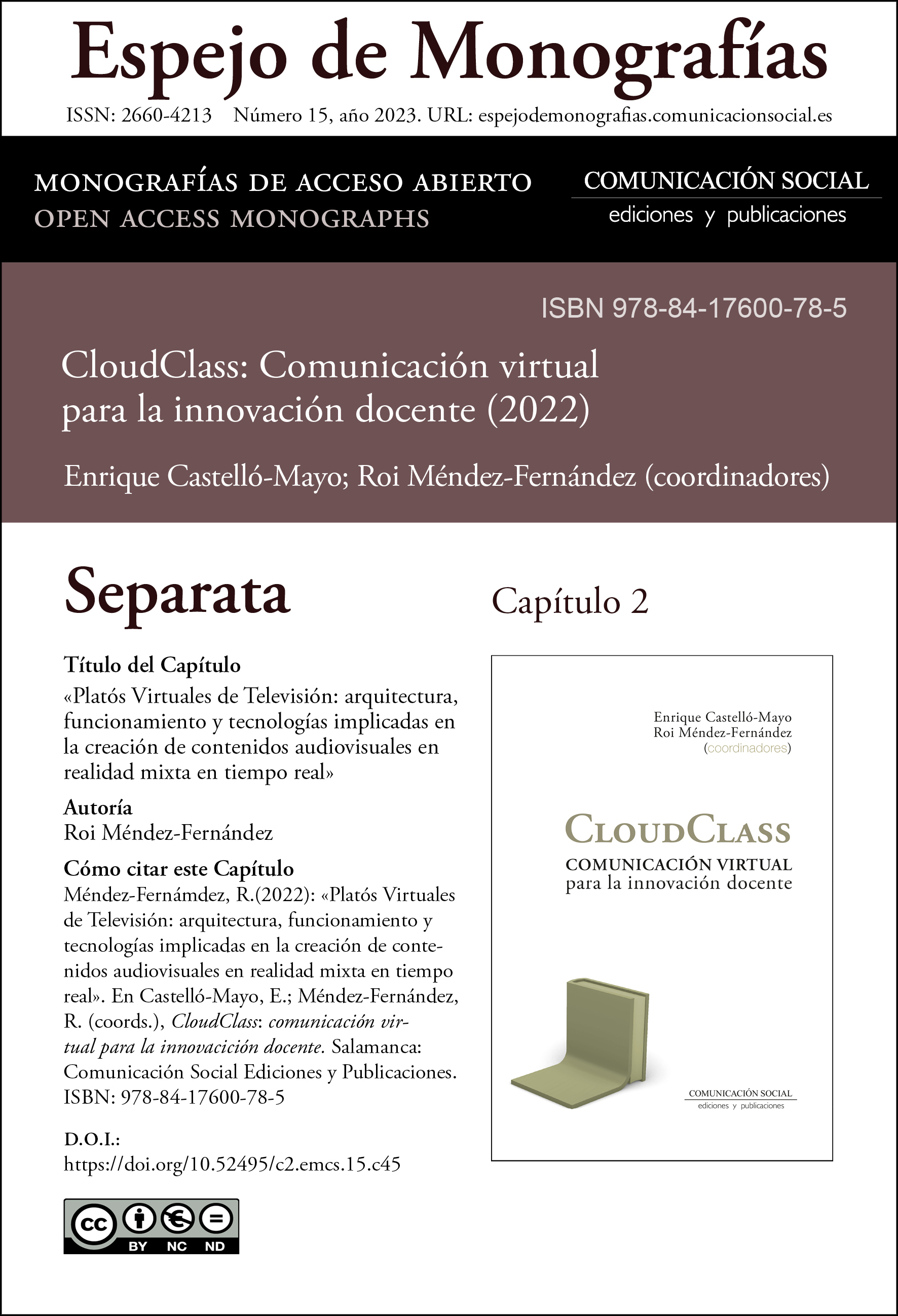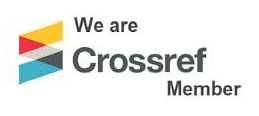Capítulo 2. Platós Virtuales de Televisión: arquitectura, funcionamiento y tecnologías implicadas en la creación de contenidos audiovisuales en realidad mixta en tiempo real
DOI:
https://doi.org/10.52495/c2.emcs.15.c45Resumen
Los platós virtuales de televisión generan contenido audiovisual en realidad mixta al combinar las imágenes reales capturadas por cámaras de video en un plató, con elementos 3D generados por ordenador. Todo este proceso se realiza en tiempo real para permitir la retransmisión en directo del contenido. Para que esto sea posible y la imagen compuesta final sea coherente a ojos del espectador es necesario el funcionamiento sinérgico de diversos elementos tecnológicos que permiten que operar en un plató de estas características se asemeje, dentro de lo posible, a operar en un entorno tradicional de televisión.
En el presente capítulo se exploran los diferentes elementos que componen un plató virtual de televisión, así como sus interrelaciones agrupándolos en cinco subsistemas principales: el subsistema de render, el de sensorización, el de captación de imagen, el de composición y el de salida de vídeo. Del mismo modo, se explorarán los últimos avances que están llegando a esta tecnología, así como ciertos elementos, actualmente no utilizados de forma común en estos entornos, que podrían adaptarse y dar un salto de calidad a las producciones realizadas en tiempo real en platós virtuales de televisión.
Palabras clave: realidad mixta, Plató virtual de televisión, tiempo real, sensorización, chroma-keying.
Descargas
Citas
Alabbasi, H.; Gradinaru, A.; Moldoveanu, F.; Moldoveanu, A. (2015). Human motion tracking evaluation using Kinect V2 sensor. E-Health and Bioengineering Conference (EHB), 2015, 1-4. https://doi.org/10.1109/EHB.2015.7391465
Anthes, C.; García-Hernández, R.J.; Wiedemann, M.; Kranzlmüller, D. (2016). State of the art of virtual reality technology. IEEE Aerospace Conference Proceedings, 2016-June. https://doi.org/10.1109/AERO.2016.7500674
De Wispelaere, T.; Tastenhoye, D.; Van Werde, V.; Young, G.; Vermost, W. (2021). Multicam Live Production in a Virtual Environment. SMPTE 2021 Annual Technical Conference, 1-10. https://doi.org/10.5594/M001932
Dedehayir, O.; Steinert, M. (2016). The hype cycle model: A review and future directions. Technological Forecasting and Social Change, 108, 28-41. https://doi.org/10.1016/J.TECHFORE.2016.04.005
Draelos, M.; Qiu, Q.; Bronstein, A.; Sapiro, G. (2015). Intel realsense = Real low cost gaze. 2015 IEEE International Conference on Image Processing (ICIP), 2520-2524. https://doi.org/10.1109/ICIP.2015.7351256
El-Wajeh, Y.A.M.; Hatton, P.V.; Lee, N.J. (2022). Unreal Engine 5 and immersive surgical training: translating advances in gaming technology into extended-reality surgical simulation training programmes. British Journal of Surgery, 109(5), 470-471. https://doi.org/10.1093/BJS/ZNAC015
Fang, Z.; Cai, L.; Juan, G.; Wang, G. (2020). Interactive movie design based on the game engine technology. ACM International Conference Proceeding Series, 1029-1033. https://doi.org/10.1145/3443467.3443900
Fukui, K.; Hayashi, M.; Yamanouchi, Y. (2015). Virtual Studio System for TV Program Production. Advanced Television and Electronic Imaging for Film and Video: SMPTE Advanced Television Imaging Conference, 80-86. https://doi.org/10.5594/M00675
Gibbs, S.; Arapis, C.; Breiteneder, C.; Lalioti, V.; Mostafawy, S.; Speier, J. (1998). Virtual studios: an overview. IEEE MultiMedia, 5(1), 18-35. https://doi.org/10.1109/93.664740
Kang, C.Y.; Li, T.Y. (2021). One-Man Movie: A System to Assist Actor Recording in a Virtual Studio. Proceedings - 2021 4th IEEE International Conference on Artificial Intelligence and Virtual Reality, AIVR 2021, 84-91. https://doi.org/10.1109/AIVR52153.2021.00022
Maksimović, V.; Petrović, M.; Jakšić, B.; Ivković, R.; Milošević, I. (2018). Effect of Illumination in Chroma Key Effect in the Realization of Virtual Television Studio. Sinteza 2018 - International Scientific Conference on Information Technology and Data Related Research, 182-188. https://doi.org/10.15308/SINTEZA-2018-182-188
Méndez, R.; Flores, J.; Castelló, E.; Viqueira, J.R.R. (2017). New distributed virtual TV set architecture for a synergistic operation of sensors and improved interaction between real and virtual worlds. Multimedia Tools and Applications 2017 77:15, 77(15), 18999-19025. https://doi.org/10.1007/S11042-017-5353-Y
Moshkovitz, M. (2000). The Virtual Studio. Technology & Techniques. Focal Press.
Pinz, A.; Brandner, M.; Ganster, H.; Kuvsej, A.; Lang, P.; Ribo, M. (2000). Hybrid Tracking for Augmented Reality. ÖGAI.
Raditya, C.; Rizky, M.; Mayranio, S.; Soewito, B. (2021). The Effectivity of Color For Chroma-Key Techniques. Procedia Computer Science, 179, 281-288. https://doi.org/10.1016/J.PROCS.2021.01.007
Sanzharov, V.V.; Frolov, V.A.; Galaktionov, V.A. (2020). Survey of Nvidia RTX Technology. Programming and Computer Software 2020 46:4, 46(4), 297–304. https://doi.org/10.1134/S0361768820030068
Swoboda, D.M. (2014). A comprehensive characterization of the asus xtion pro depth sensor. I: European Conference on Educational Robotics, 3.
Wojdala, A. (1998). Challenges of virtual set technology. IEEE Multimedia, 5(1), 50-57. https://doi.org/10.1109/93.664742
Yagi, N.; Kobayashi, H.; Nishioka, Y.; Izumida, N. (2021). Interaction support for virtual studio by vibration feedback. Https://Doi.Org/10.1117/12.2589959, 11766, 531-536. https://doi.org/10.1117/12.2589959

Publicado
Cómo citar
Número
Sección
Licencia

Esta obra está bajo una licencia internacional Creative Commons Atribución-NoComercial 4.0.
Los artículos publicados en la revista se distribuyen con la Licencia Creative Commons Atribución-NoComercial-SinDerivadas 4.0 Internacional










